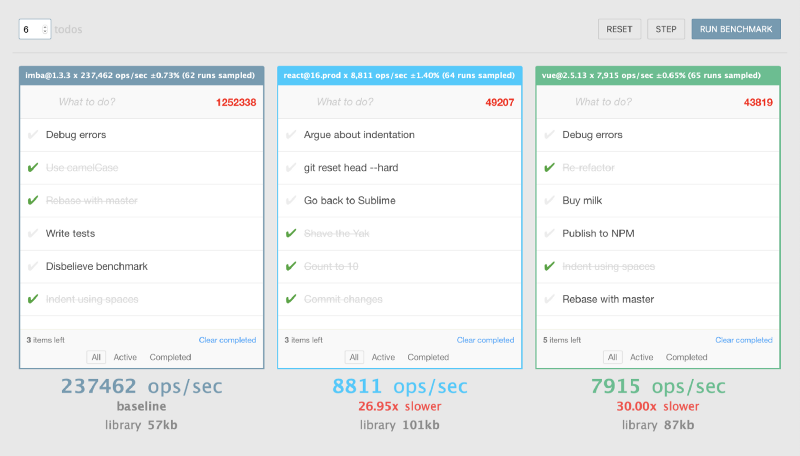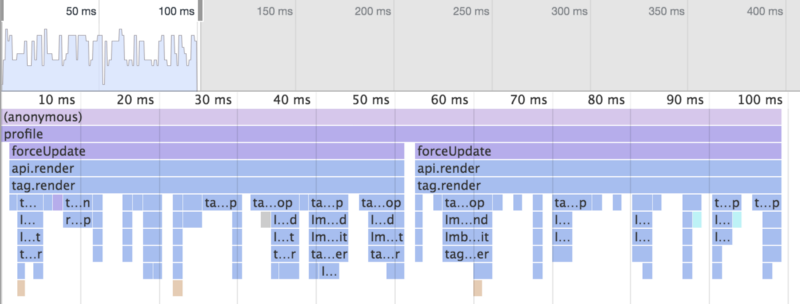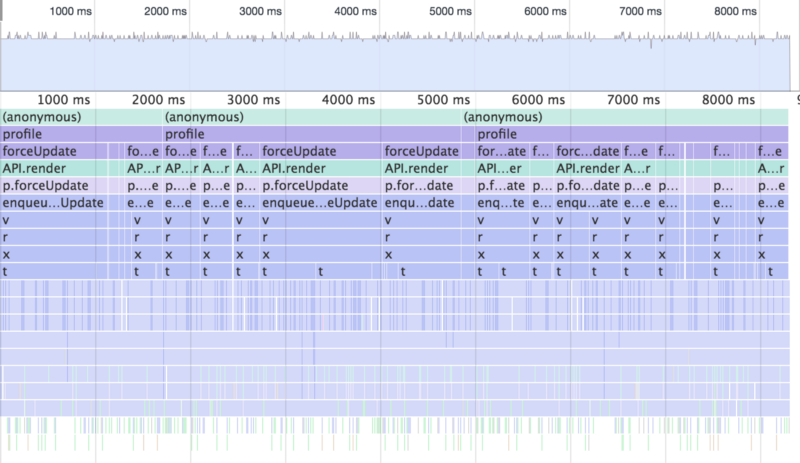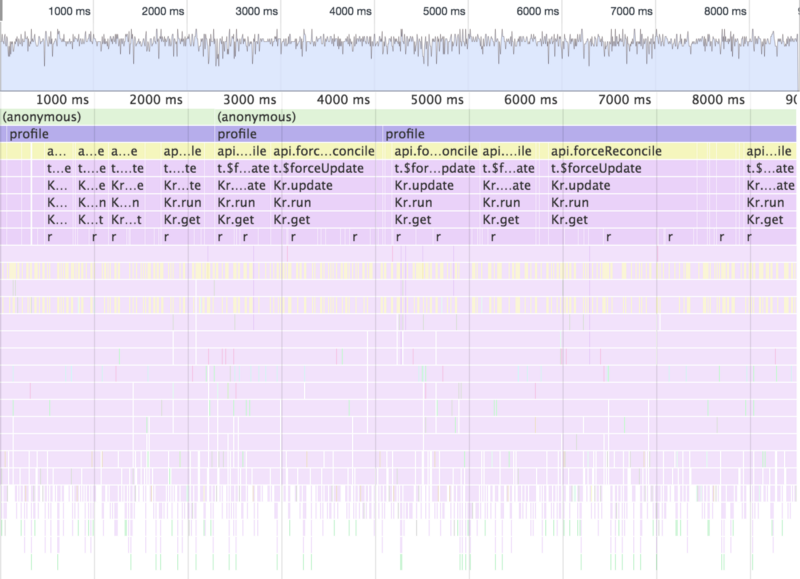by Sindre Osen Aarsaether
The Virtual DOM is slow. Meet the Memoized DOM.
Moving beyond the Virtual DOM and State Management

The virtual DOM was a fantastic innovation. It brought about a much more productive way of writing web applications by allowing us to write our views in a declarative manner.
This big benefit has little to do with performance of the initial render. Instead, it is the process of updating the DOM to reflect changes in your state has become much faster.
This process of bringing the DOM in sync with the state is often referred to as DOM reconciliation.
If we had an infinitely fast reconciler, we could vastly simplify our applications by rendering everything on every single frame. The state layer would never need to know about views at all — much less send out events and track which views need to react when certain parts of the state change. The view would always be in sync with the data, no matter what you threw at it.
Sadly, virtual DOM implementations are not infinitely fast. They are, in fact, surprisingly slow. Thankfully, many have jumped on the Immutability™ bandwagon, in which case the virtual DOM thanks you! Others wrap all state in observables (e.g. mobx), and keep track of which view depends on what state. This allows you to reconcile only parts of your view, but comes with its own set of drawbacks.
The biggest issue is that we tend to decide how to manage our application state based on our view layer. What if we could get better performance in a world where the data layer and view layer don’t really know or care about each other?
Meet the Memoized DOM
Imba is a programming language for the web. It powers the interactive screencasting platform scrimba.com, of which I am the lead developer. Imba was born to make developing web applications fun again. It features a clean and readable syntax inspired by Ruby. It compiles to readable and performant JavaScript, and works inside the existing ecosystem.

Besides a clean and readable syntax, the biggest benefit of Imba is that it truly treats DOM elements as first-class citizens, on a much deeper level than JSX. It allows you to write views declaratively, yet it does not use a virtual DOM. Instead, Imba compiles views to a memoized DOM, which turns out to be an order of magnitude faster.
How it works
The general idea is that we create lightweight wrappers around DOM elements, and compile declarative views to chains of setters, each modifying the underlying DOM directly.
tag AppView
def render
<self>
<h1.title> "Welcome"
<p.desc .red=(Math.random > 0.5)> "Roulette"The Imba view above will roughly compile into the following javascript:
class AppView extends Imba.Tag {
render() {
var $ = this.$; // inline cache for tag
return this.setChildren($.$ = $.$ || [
Imba.tag('h1',$).flag('title').setText("Welcome"),
Imba.tag('p',$).flag('desc').setText("Roulette")
]).synced(
$[1].flagIf('red',Math.random() > 0.5)
);
}
}This is a very simple example to illustrate the basic concept. During compilation we split creation and updates into separate branches. The first time render is called for an <AppView> the children will be created and static attributes will be set. On all subsequent calls the only real work we do is flip the className of our <p>. Albeit much more complex, the same concept is used for conditionals, loops, and everything else inside tag trees.
If you’re interested in how it really works I recommend reading this intro.
Benchmark
React is fast, they said. React is fast enough, they said. React Fiber will be fast enough, they said.
Most benchmarks test things like “insert/shuffle/remove 1000 rows”. This gives little indication about real-world performance. When there are hundres of changes, most of the difference is eaten up by actual DOM mutations, repainting, etc. It fails to measure the most important metric.
If you truly want to test the performance of DOM reconciliation, you need to look at how quickly the implementation brings the DOM in sync with the state, especially when there are few/no changes.
So, to capture a realistic view of the reconciler performance, we could change a small part of the application state in each iteration, and then measure the time it takes to forcefully bring the view in sync with this changed state. The view should not be listening to any part of the state, and the state should not need to notify anyone whether it has changed.

This benchmark steps through a deterministic sequence of state alterations, doing at most one change per iteration. We are measuring the time it takes to reconcile the whole application view after:
- Toggling the completion of a task
- Removing a task
- Inserting a task
- Renaming a task
- Doing nothing
Results
Running the benchmark on an iMac (4GHz i7) yields the following results:
Safari 11
- Imba 1.3: 360458 ops / sec
- React 16.2: 9752 ops / sec — 36.96x slower
- Vue 2.5: 8719 ops / sec — 41.34x slower
Chrome 65
- Imba 1.3: 282484 ops / sec
- React 16.2: 8882 ops / sec — 31.81x slower
- Vue 2.5: 8103 ops / sec — 34.86x slower
Firefox 58
- Imba 1.3: 234334 ops / sec
- React 16.2: 5075 ops / sec — 46.17x slower
- Vue 2.5: 3119 ops / sec — 75.13x slower
This seems outrageous right? Surely, it cannot be right.
- All implementations are really reconciling on every step.
- All implementations are blocking, synchronous, and deterministic.
- All implementations are performing the same amount of DOM mutations.
- Yes, we are using the minified production build of React. The development version is 200x slower than Imba on the same test.
- The memoized DOM creates practically no garbage during an iteration, uses less memory overall, and is conceptually very simple.
All the implementations can probably be optimized more. I’m very happy to accept pull-requests at GitHub. To be clear, I have tremendous respect for what React has achieved, and I truly love Vue. Imba has taken a lot of inspiration from it. I suspect it should be possible to compile Vue templates using a similar approach, and would love for someone to give it a go!
Profiling
Let’s test the raw reconciler performance when there aren’t even any changes. This removes the time spent doing actual DOM mutations from the equation, and gives us a good picture about how much work is going on during reconciliation. The charted CPU profile from Chrome gives a visual indication of how much less work is done with the memoized DOM technique.
Imba 1.3

React 16.2

Vue 2.5

Does it scale?
“There are A LOT, and I mean, A LOT of small little projects that claim more speed, easier development, but on closer inspection usually lack very important features (such as module life cycle hooks) and, of course without them the performance is higher, but the flexibility to use those libraries beyond a todo list application is limited.”
This is a quote from someone who read through an early draft of this article, and I would like to tackle it head on. The performance difference is not limited to a simple test, quite the contrary. Imba has been used in production for several years at scrimba.com, but it is still not for the faint of heart. For most developers the massive ecosystems for Vue and React will be hard (and probably unwise) to leave behind. The Imba documentation still leaves a lot to be desired, but we are improving it every day.
Does it matter?
I’m sure you’ve heard that React is fast enough. But fast enough for what? It doesn’t really matter if React was 15% faster, but with an order of magnitude improvement we can start to explore simpler ways to build applications.

It’s not about the perceived speed, but about what it lets you do. At scrimba.com we don’t worry about keeping the view in sync with the state. We don’t worry about tracking when state has changed. Our data models are not observable. We just render. Whenever. And it’s liberating.
